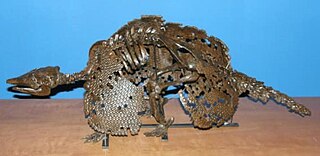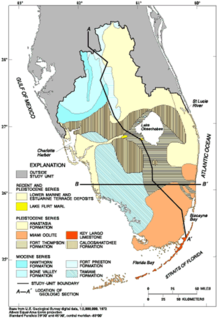
Megalonychidae is an extinct family of sloths including the extinct Megalonyx. Megalonychids first appeared in the early Oligocene, about 35 million years (Ma) ago, in southern Argentina (Patagonia). There is actually one possible find dating to the Eocene, about 40 Ma ago, on Seymour Island in Antarctica. They first reached North America by island-hopping across the Central American Seaway, about 9 million years ago, prior to formation of the Isthmus of Panama about 2.7 million years ago. Some megalonychid lineages increased in size as time passed. The first species of these were small and may have been partly tree-dwelling, whereas the Pliocene species were already approximately half the size of the huge Late Pleistocene Megalonyx jeffersonii from the last ice age.

Platygonus is an extinct genus of herbivorous peccaries of the family Tayassuidae, endemic to North and South America from the Miocene through Pleistocene epochs, existing for about 10.289 million years. P. compressus stood 2.5 feet tall.

Pachyarmatherium is a genus of extinct large armadillo-like cingulates found in North and South America from the Pliocene and Pleistocene epochs, related to the extant armadillos and the extinct pampatheres and glyptodonts. It was present from 4.9 Mya to 11,000 years ago, existing for approximately 4.889 million years.

The giant pika or Wharton's pika is an extinct mammal species in the family Ochotonidae. It lived during the Pleistocene and early Holocene in northern parts of North America. Very similar forms have also been found also in Siberia.

The Bermont Formation is a geologic formation in Florida. It preserves mostly invertebrate fossils that date back to the Middle Pleistocene. Most of the fossils preserved are extant mollusk shells. It is mined commercially along with similar formations, to produce shell fill for construction.
![Caloosahatchee Formation Geologic formation in Florida. It preserves fossils dating back to the [[Pleistocene]].](https://upload.wikimedia.org/wikipedia/commons/thumb/b/bd/Hystrivasum_horridum_01.JPG/320px-Hystrivasum_horridum_01.JPG)
The Caloosahatchee Formation is a geologic formation in Florida. It preserves fossils dating back to the Pleistocene.
The Fort Preston Sand is a geologic formation in Florida. It preserves fossils dating back to the Neogene period.
The Coffee Mill Hammock Formation is a geologic formation in Florida. The formation is about two-feet thick and is composed of shell marl. It sits on top of the Fort Thompson Formation and preserves fossils from the Late Pleistocene, predominantly Chione cancellata. It can be seen at Goodno's Landing, Fort Thompson, and at Coffee Mill Hammock, 12 north of LaBelle, Florida, in Glades County.

The Key Largo Limestone is a geologic formation in Florida. It is a fossilized coral reef. The formation is exposed along the upper and middle Florida Keys from Soldier Key to the Bahia Honda Channel. The islands form a long narrow arc concentric with the inner edge of the Florida Straits and with the Florida Reef. The limestone includes fossils of corals, mollusks and bryozoans. Fossilized coral head formations are visible in some exposures. The Key Largo Limestone continues in a narrow band underwater just offshore of the coast of Florida north of Soldier Key to the middle of the Palm Beach County coast, and southward just offshore of the lower Florida Keys to the Dry Tortugas.

The Miami Limestone, originally called Miami Oolite, is a geologic formation of limestone in southeastern Florida.
The Fern Glen Formation is a geologic formation in eastern and southeastern Missouri. It preserves fossils dating back to the Osagean Series of the Mississippian subperiod.
The Beaumont Formation is a geologic formation in Texas. It preserves fossils dating back to the Pleistocene period.
The Camp Rice Formation is a geologic formation in west Texas and southern New Mexico. It preserves fossils of the Pliocene-Pleistocene. These include the distinctive Tonuco Mountain Local Fauna.
The Alamosa Formation is a geologic formation in Colorado. It preserves fossils. The formation was deposited by Lake Alamosa, a paleolake that existed from the Pliocene to the middle Pleistocene.

The Purisima Formation is a geologic formation in California. It preserves fossils dating from the Late Miocene to Early Pleistocene.
The Brawley Formation is a geologic formation in the Colorado Desert of southern California, located in northwestern Imperial County and eastern San Diego County.
The Palm Spring Formation is a Pleistocene Epoch geologic formation in the eastern Colorado Desert of Imperial County and San Diego County County, Southern California.
The Turlock Lake Formation is an Early Pleistocene geologic formation in the Sierra Nevada foothills in Sacramento County, California. Cities in/over the formation's area include Citrus Heights, Carmichael, and Roseville.
The Scarborough Formation is a Pleistocene geologic formation in Ontario.






![Caloosahatchee Formation Geologic formation in Florida. It preserves fossils dating back to the [[Pleistocene]].](https://upload.wikimedia.org/wikipedia/commons/thumb/b/bd/Hystrivasum_horridum_01.JPG/320px-Hystrivasum_horridum_01.JPG)

